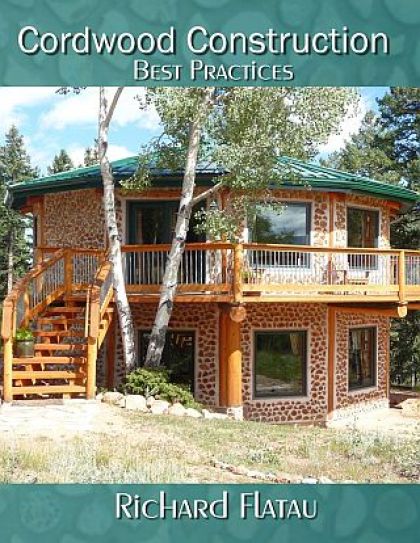 Stu and Midge have been building a unique, off-grid cordwood cabin in western Wisconsin using cordwood for some walls and straw/clay (also known as light straw/clay) for others. The cabin is 12′ x 16′. Built on strengthened posts and piers. The cordwood walls were set at 8″ to accommodate the foundation load. There is an interior timber frame which showcases Stu’s burgeoning woodworking skills.
Stu and Midge have been building a unique, off-grid cordwood cabin in western Wisconsin using cordwood for some walls and straw/clay (also known as light straw/clay) for others. The cabin is 12′ x 16′. Built on strengthened posts and piers. The cordwood walls were set at 8″ to accommodate the foundation load. There is an interior timber frame which showcases Stu’s burgeoning woodworking skills. “I’ve looked at bottles from both sides now…” Colored bottles are now being used on the outside and the inside. This adds color to the exterior & the interior wall and still lets in a fair amount of light. Folks have been experimenting with wrapping LED lights around the bottles to have them glow in the dark.
“I’ve looked at bottles from both sides now…” Colored bottles are now being used on the outside and the inside. This adds color to the exterior & the interior wall and still lets in a fair amount of light. Folks have been experimenting with wrapping LED lights around the bottles to have them glow in the dark.  According to all accounts, Midge is becoming a tuck pointing maven and master plasterer. Note how the window box is attached to an interior post via a metal framing flange.
According to all accounts, Midge is becoming a tuck pointing maven and master plasterer. Note how the window box is attached to an interior post via a metal framing flange. The next days’ supply of cordwood is placed on the covered porch for “easy pickin’s.”
The next days’ supply of cordwood is placed on the covered porch for “easy pickin’s.”  The strawbale wall has an earthen plaster finish and often requires a scratch coat and a finished coat. The finished coat is done with a white plaster (see below).
The strawbale wall has an earthen plaster finish and often requires a scratch coat and a finished coat. The finished coat is done with a white plaster (see below).  (Above) The interior has the requisite heater for cold weather Wisconsin building.
(Above) The interior has the requisite heater for cold weather Wisconsin building.
(Below) The framework, timber-framed by Stu, is solid as a rock. 
 A good look at the post and pier foundation with the straw/clay wall to the left.
A good look at the post and pier foundation with the straw/clay wall to the left.  The recycled door is very attractive when looking from either side.
The recycled door is very attractive when looking from either side.
The straw/clay is mixed wet and then placed in between the framing studs. It has an R-value of 1.6 per inch (almost exactly the same as cordwood).  After the straw/clay is in place, it will be covered with an earthen coating from top to bottom. It will then be finished with a final coat of white plaster.
After the straw/clay is in place, it will be covered with an earthen coating from top to bottom. It will then be finished with a final coat of white plaster.
Building a cabin using various natural building techniques can often showcase the best of both worlds. Strawbale is the best insulator and cordwood gives good R-value and adds a WOW factor to the building. We have seen cob and cordwood, strawbale and cordwood and horizontal and vertical logs with cordwood. The key rule of thumb is that “cordwood plays well with the other styles.” Meaning it is easy to integrate with another style or two. Let your imagination and your dreams assist you in your planning.
Should you wish to learn how to build a cordwood cottage, cabin or home, please visit www.cordwoodconstruction.org While you are there, click on the pictures, read the brief articles, check out the latest workshops and newsletter and if you are interested click on the Online Bookstore to see all the cordwood literature available in print, video and ebook format.
If you have questions that aren’t answered on the website you can email me at richardflatau@gmail.com
Readers have requested a brief bio, so here goes:
“Richard & Becky Flatau built their mortgage-free cordwood home in 1979 in Merrill, Wisconsin. Since then, they have written books, conducted workshops, facilitated the 2005, 2011 and 2015 Cordwood Conferences and provided consultation for cordwood builders. Cordwood Construction: Best Practices DVD, Cordwood Construction Best Practices (print) and Cordwood Conference Papers 2015 are the newest publications available from their online cordwood bookstore. www.cordwoodconstruction.org
Click on the picture if you would like to order this “best of the best” DVD.

















